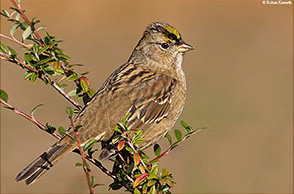 |
Golden-crowned Sparrow
Zonotrichia atricapilla |
|
|
STANFORD LOCATIONS: Common migrant and winter resident virtually throughout campus, occurring in a variety of habitat types but usually found in close proximity to the cover of brushy vegetation. Often occurs in flocks with White-crowned Sparrows, although more closely tied to shrubs and brushy vegetation than tall grasses and forbs away from brush, as is the White-crowned. Forages primarily on or near the ground, although in spring flocks forage in the crowns of flowering oaks and eucalyptus. |
 |
Location |
Type |
Mating System |
Parental Care |
2ndary Diet |
Strategy |
|
|
|
|
I: ? DAYS ALTRICIAL |
|
|
|
0 - 2.5 feet |
|
MONOG? |
MF |
BERRIES |
| BREEDING: | Montane thickets and shrubs, dwarf conifs, brushy canyons. 1? brood. |
| DISPLAYS: | ? |
| NEST: | Usu sunk in ground at base of small tree or on horizontal branch of low tree; bulky, of grass, leaves, twigs, bark, moss, lined with fine grass, feathers, fur. |
| EGGS: | Creamy or pale bluish-white, marked with reddish-browns. 0.9" (23 mm). |
| DIET: | Nestlings probably fed 100% insects. In winter, buds, flowers, fresh seedlings (esp of annuals), seeds. |
| CONSERVATION: | Winters s to n Baja. |
| NOTES: | Male feeds incubating female. Details of breeding biology largely unknown. Stable winter flocks, often with White-crowned Sparrows, show site attachment to wintering territory. |
| ESSAYS: | Adaptations for Flight; Site Tenacity; Mixed-Species Flocking; How Do We Find Out About Bird Biology? |
| REFERENCES: | Pearson, 1979. |
| Help | Abbreviations | Species-Alphabetical | Species-Taxonomic | Essays-Alphabetical | |
| Except for Stanford Locations, the material in this species treatment is taken, with permission, from The Birder's Handbook (Paul Ehrlich, David Dobkin, & Darryl Wheye, Simon & Schuster, NY. 1988). | |||||